Comprehensive Report: Malayan Union, Electoral System in Malaysia
VerifiedAdded on 2020/07/22
|7
|1870
|471
Report
AI Summary
This report delves into the historical context of Malaysia, starting from early Malay kingdoms to the formation of Malaysia. It analyzes the British government's motivations for establishing the Malayan Union after World War II, including the creation of a uniform political system, control over the economy, and providing citizenship to non-Malays. The report outlines the reasons for the union's failure, primarily due to strong opposition from the Malay population. Furthermore, the report describes the electoral process in Malaysia, including the two types of elections, the roles of the Dewan Rakyat and State Legislative Assemblies, and the key stages of the election process, from candidate nomination to the announcement of results. It also touches upon the constitutional monarchy and parliamentary democracy, ethnic divisions, and the impact of electoral system rules, including the concepts of gerrymandering and the importance of impartiality in ensuring fair elections.

Paraphrase This Document
Need a fresh take? Get an instant paraphrase of this document with our AI Paraphraser
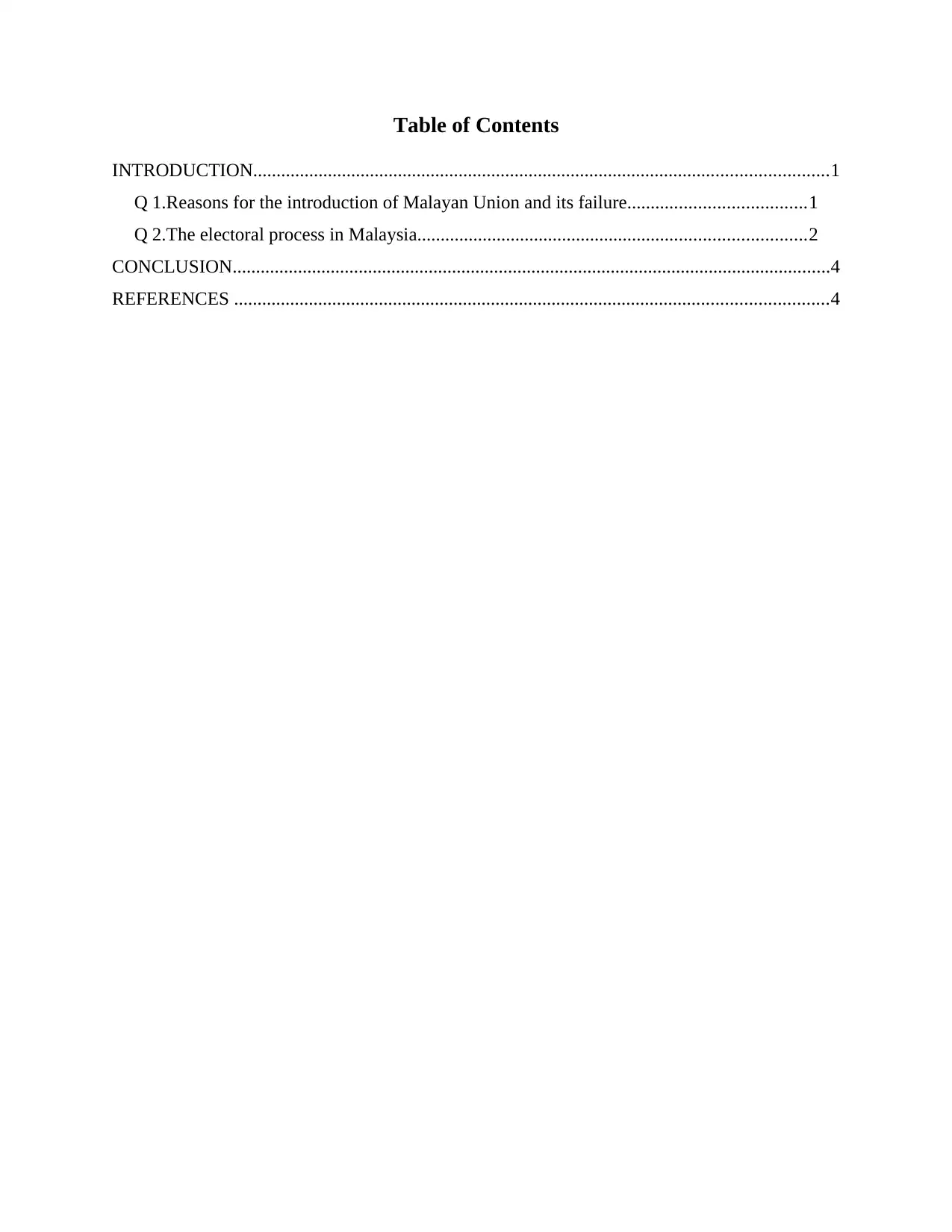
Table of Contents
INTRODUCTION...........................................................................................................................1
Q 1.Reasons for the introduction of Malayan Union and its failure......................................1
Q 2.The electoral process in Malaysia...................................................................................2
CONCLUSION................................................................................................................................4
REFERENCES ...............................................................................................................................4
INTRODUCTION...........................................................................................................................1
Q 1.Reasons for the introduction of Malayan Union and its failure......................................1
Q 2.The electoral process in Malaysia...................................................................................2
CONCLUSION................................................................................................................................4
REFERENCES ...............................................................................................................................4
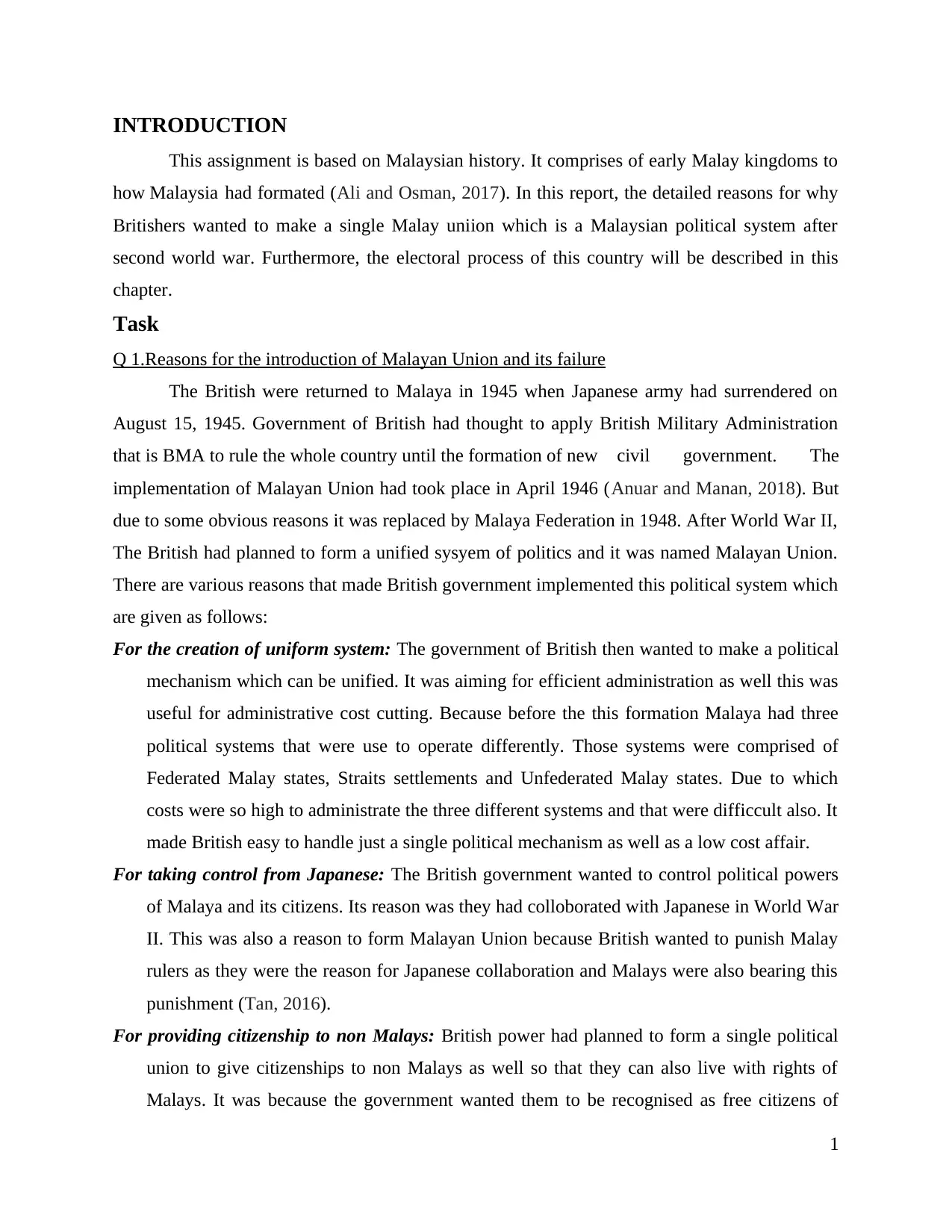
INTRODUCTION
This assignment is based on Malaysian history. It comprises of early Malay kingdoms to
how Malaysia had formated (Ali and Osman, 2017). In this report, the detailed reasons for why
Britishers wanted to make a single Malay uniion which is a Malaysian political system after
second world war. Furthermore, the electoral process of this country will be described in this
chapter.
Task
Q 1.Reasons for the introduction of Malayan Union and its failure
The British were returned to Malaya in 1945 when Japanese army had surrendered on
August 15, 1945. Government of British had thought to apply British Military Administration
that is BMA to rule the whole country until the formation of new civil government. The
implementation of Malayan Union had took place in April 1946 (Anuar and Manan, 2018). But
due to some obvious reasons it was replaced by Malaya Federation in 1948. After World War II,
The British had planned to form a unified sysyem of politics and it was named Malayan Union.
There are various reasons that made British government implemented this political system which
are given as follows:
For the creation of uniform system: The government of British then wanted to make a political
mechanism which can be unified. It was aiming for efficient administration as well this was
useful for administrative cost cutting. Because before the this formation Malaya had three
political systems that were use to operate differently. Those systems were comprised of
Federated Malay states, Straits settlements and Unfederated Malay states. Due to which
costs were so high to administrate the three different systems and that were difficcult also. It
made British easy to handle just a single political mechanism as well as a low cost affair.
For taking control from Japanese: The British government wanted to control political powers
of Malaya and its citizens. Its reason was they had colloborated with Japanese in World War
II. This was also a reason to form Malayan Union because British wanted to punish Malay
rulers as they were the reason for Japanese collaboration and Malays were also bearing this
punishment (Tan, 2016).
For providing citizenship to non Malays: British power had planned to form a single political
union to give citizenships to non Malays as well so that they can also live with rights of
Malays. It was because the government wanted them to be recognised as free citizens of
1
This assignment is based on Malaysian history. It comprises of early Malay kingdoms to
how Malaysia had formated (Ali and Osman, 2017). In this report, the detailed reasons for why
Britishers wanted to make a single Malay uniion which is a Malaysian political system after
second world war. Furthermore, the electoral process of this country will be described in this
chapter.
Task
Q 1.Reasons for the introduction of Malayan Union and its failure
The British were returned to Malaya in 1945 when Japanese army had surrendered on
August 15, 1945. Government of British had thought to apply British Military Administration
that is BMA to rule the whole country until the formation of new civil government. The
implementation of Malayan Union had took place in April 1946 (Anuar and Manan, 2018). But
due to some obvious reasons it was replaced by Malaya Federation in 1948. After World War II,
The British had planned to form a unified sysyem of politics and it was named Malayan Union.
There are various reasons that made British government implemented this political system which
are given as follows:
For the creation of uniform system: The government of British then wanted to make a political
mechanism which can be unified. It was aiming for efficient administration as well this was
useful for administrative cost cutting. Because before the this formation Malaya had three
political systems that were use to operate differently. Those systems were comprised of
Federated Malay states, Straits settlements and Unfederated Malay states. Due to which
costs were so high to administrate the three different systems and that were difficcult also. It
made British easy to handle just a single political mechanism as well as a low cost affair.
For taking control from Japanese: The British government wanted to control political powers
of Malaya and its citizens. Its reason was they had colloborated with Japanese in World War
II. This was also a reason to form Malayan Union because British wanted to punish Malay
rulers as they were the reason for Japanese collaboration and Malays were also bearing this
punishment (Tan, 2016).
For providing citizenship to non Malays: British power had planned to form a single political
union to give citizenships to non Malays as well so that they can also live with rights of
Malays. It was because the government wanted them to be recognised as free citizens of
1
⊘ This is a preview!⊘
Do you want full access?
Subscribe today to unlock all pages.

Trusted by 1+ million students worldwide
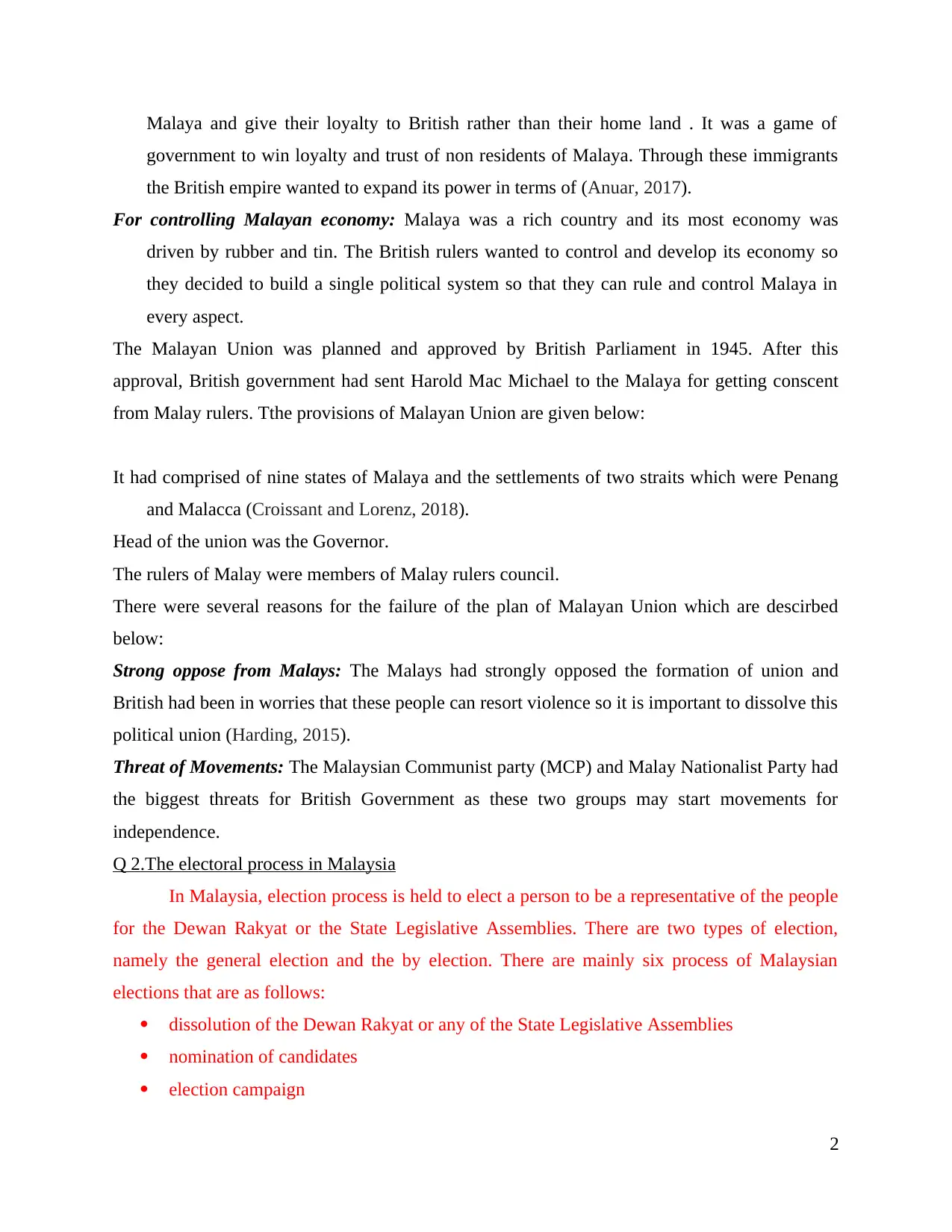
Malaya and give their loyalty to British rather than their home land . It was a game of
government to win loyalty and trust of non residents of Malaya. Through these immigrants
the British empire wanted to expand its power in terms of (Anuar, 2017).
For controlling Malayan economy: Malaya was a rich country and its most economy was
driven by rubber and tin. The British rulers wanted to control and develop its economy so
they decided to build a single political system so that they can rule and control Malaya in
every aspect.
The Malayan Union was planned and approved by British Parliament in 1945. After this
approval, British government had sent Harold Mac Michael to the Malaya for getting conscent
from Malay rulers. Tthe provisions of Malayan Union are given below:
It had comprised of nine states of Malaya and the settlements of two straits which were Penang
and Malacca (Croissant and Lorenz, 2018).
Head of the union was the Governor.
The rulers of Malay were members of Malay rulers council.
There were several reasons for the failure of the plan of Malayan Union which are descirbed
below:
Strong oppose from Malays: The Malays had strongly opposed the formation of union and
British had been in worries that these people can resort violence so it is important to dissolve this
political union (Harding, 2015).
Threat of Movements: The Malaysian Communist party (MCP) and Malay Nationalist Party had
the biggest threats for British Government as these two groups may start movements for
independence.
Q 2.The electoral process in Malaysia
In Malaysia, election process is held to elect a person to be a representative of the people
for the Dewan Rakyat or the State Legislative Assemblies. There are two types of election,
namely the general election and the by election. There are mainly six process of Malaysian
elections that are as follows:
dissolution of the Dewan Rakyat or any of the State Legislative Assemblies
nomination of candidates
election campaign
2
government to win loyalty and trust of non residents of Malaya. Through these immigrants
the British empire wanted to expand its power in terms of (Anuar, 2017).
For controlling Malayan economy: Malaya was a rich country and its most economy was
driven by rubber and tin. The British rulers wanted to control and develop its economy so
they decided to build a single political system so that they can rule and control Malaya in
every aspect.
The Malayan Union was planned and approved by British Parliament in 1945. After this
approval, British government had sent Harold Mac Michael to the Malaya for getting conscent
from Malay rulers. Tthe provisions of Malayan Union are given below:
It had comprised of nine states of Malaya and the settlements of two straits which were Penang
and Malacca (Croissant and Lorenz, 2018).
Head of the union was the Governor.
The rulers of Malay were members of Malay rulers council.
There were several reasons for the failure of the plan of Malayan Union which are descirbed
below:
Strong oppose from Malays: The Malays had strongly opposed the formation of union and
British had been in worries that these people can resort violence so it is important to dissolve this
political union (Harding, 2015).
Threat of Movements: The Malaysian Communist party (MCP) and Malay Nationalist Party had
the biggest threats for British Government as these two groups may start movements for
independence.
Q 2.The electoral process in Malaysia
In Malaysia, election process is held to elect a person to be a representative of the people
for the Dewan Rakyat or the State Legislative Assemblies. There are two types of election,
namely the general election and the by election. There are mainly six process of Malaysian
elections that are as follows:
dissolution of the Dewan Rakyat or any of the State Legislative Assemblies
nomination of candidates
election campaign
2
Paraphrase This Document
Need a fresh take? Get an instant paraphrase of this document with our AI Paraphraser
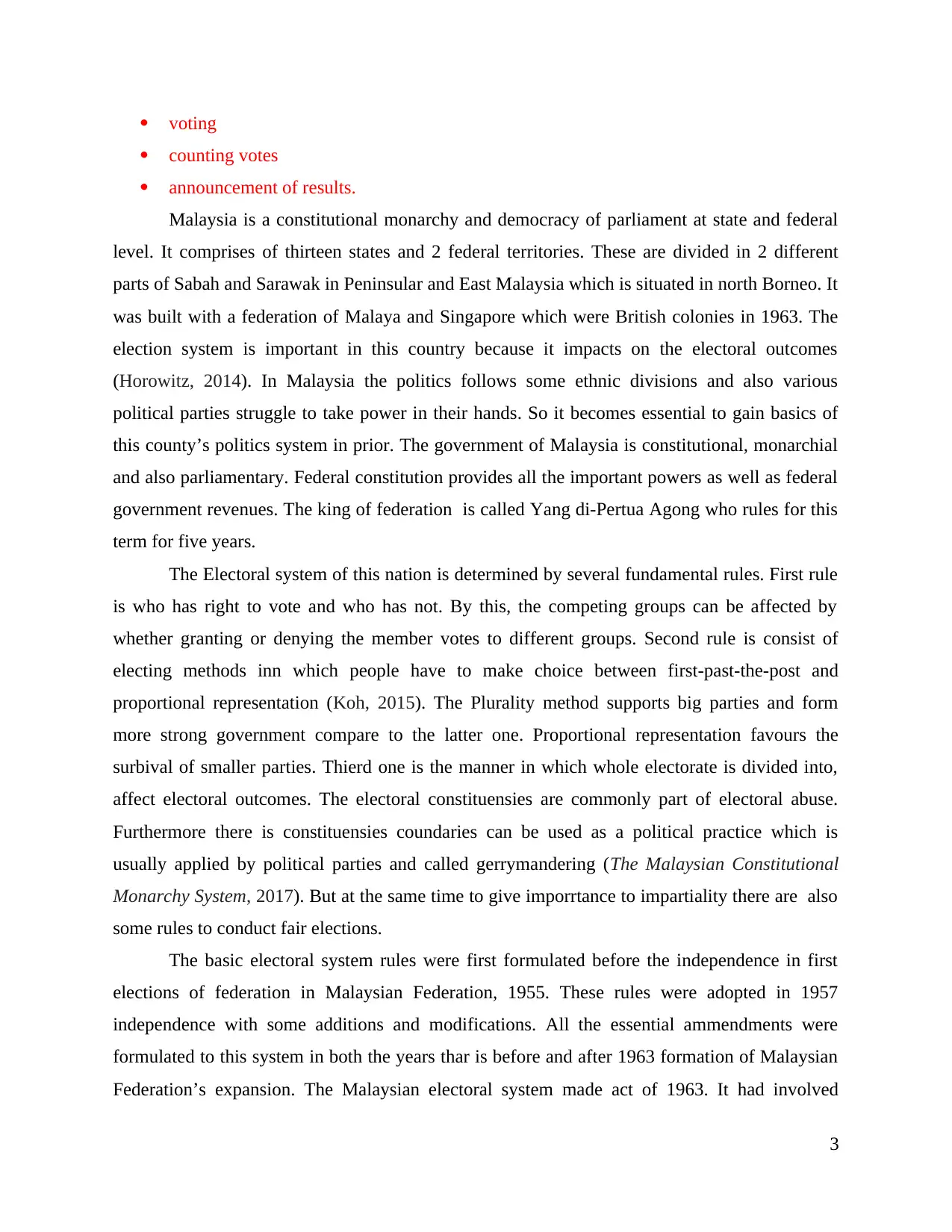
voting
counting votes
announcement of results.
Malaysia is a constitutional monarchy and democracy of parliament at state and federal
level. It comprises of thirteen states and 2 federal territories. These are divided in 2 different
parts of Sabah and Sarawak in Peninsular and East Malaysia which is situated in north Borneo. It
was built with a federation of Malaya and Singapore which were British colonies in 1963. The
election system is important in this country because it impacts on the electoral outcomes
(Horowitz, 2014). In Malaysia the politics follows some ethnic divisions and also various
political parties struggle to take power in their hands. So it becomes essential to gain basics of
this county’s politics system in prior. The government of Malaysia is constitutional, monarchial
and also parliamentary. Federal constitution provides all the important powers as well as federal
government revenues. The king of federation is called Yang di-Pertua Agong who rules for this
term for five years.
The Electoral system of this nation is determined by several fundamental rules. First rule
is who has right to vote and who has not. By this, the competing groups can be affected by
whether granting or denying the member votes to different groups. Second rule is consist of
electing methods inn which people have to make choice between first-past-the-post and
proportional representation (Koh, 2015). The Plurality method supports big parties and form
more strong government compare to the latter one. Proportional representation favours the
surbival of smaller parties. Thierd one is the manner in which whole electorate is divided into,
affect electoral outcomes. The electoral constituensies are commonly part of electoral abuse.
Furthermore there is constituensies coundaries can be used as a political practice which is
usually applied by political parties and called gerrymandering (The Malaysian Constitutional
Monarchy System, 2017). But at the same time to give imporrtance to impartiality there are also
some rules to conduct fair elections.
The basic electoral system rules were first formulated before the independence in first
elections of federation in Malaysian Federation, 1955. These rules were adopted in 1957
independence with some additions and modifications. All the essential ammendments were
formulated to this system in both the years thar is before and after 1963 formation of Malaysian
Federation’s expansion. The Malaysian electoral system made act of 1963. It had involved
3
counting votes
announcement of results.
Malaysia is a constitutional monarchy and democracy of parliament at state and federal
level. It comprises of thirteen states and 2 federal territories. These are divided in 2 different
parts of Sabah and Sarawak in Peninsular and East Malaysia which is situated in north Borneo. It
was built with a federation of Malaya and Singapore which were British colonies in 1963. The
election system is important in this country because it impacts on the electoral outcomes
(Horowitz, 2014). In Malaysia the politics follows some ethnic divisions and also various
political parties struggle to take power in their hands. So it becomes essential to gain basics of
this county’s politics system in prior. The government of Malaysia is constitutional, monarchial
and also parliamentary. Federal constitution provides all the important powers as well as federal
government revenues. The king of federation is called Yang di-Pertua Agong who rules for this
term for five years.
The Electoral system of this nation is determined by several fundamental rules. First rule
is who has right to vote and who has not. By this, the competing groups can be affected by
whether granting or denying the member votes to different groups. Second rule is consist of
electing methods inn which people have to make choice between first-past-the-post and
proportional representation (Koh, 2015). The Plurality method supports big parties and form
more strong government compare to the latter one. Proportional representation favours the
surbival of smaller parties. Thierd one is the manner in which whole electorate is divided into,
affect electoral outcomes. The electoral constituensies are commonly part of electoral abuse.
Furthermore there is constituensies coundaries can be used as a political practice which is
usually applied by political parties and called gerrymandering (The Malaysian Constitutional
Monarchy System, 2017). But at the same time to give imporrtance to impartiality there are also
some rules to conduct fair elections.
The basic electoral system rules were first formulated before the independence in first
elections of federation in Malaysian Federation, 1955. These rules were adopted in 1957
independence with some additions and modifications. All the essential ammendments were
formulated to this system in both the years thar is before and after 1963 formation of Malaysian
Federation’s expansion. The Malaysian electoral system made act of 1963. It had involved
3
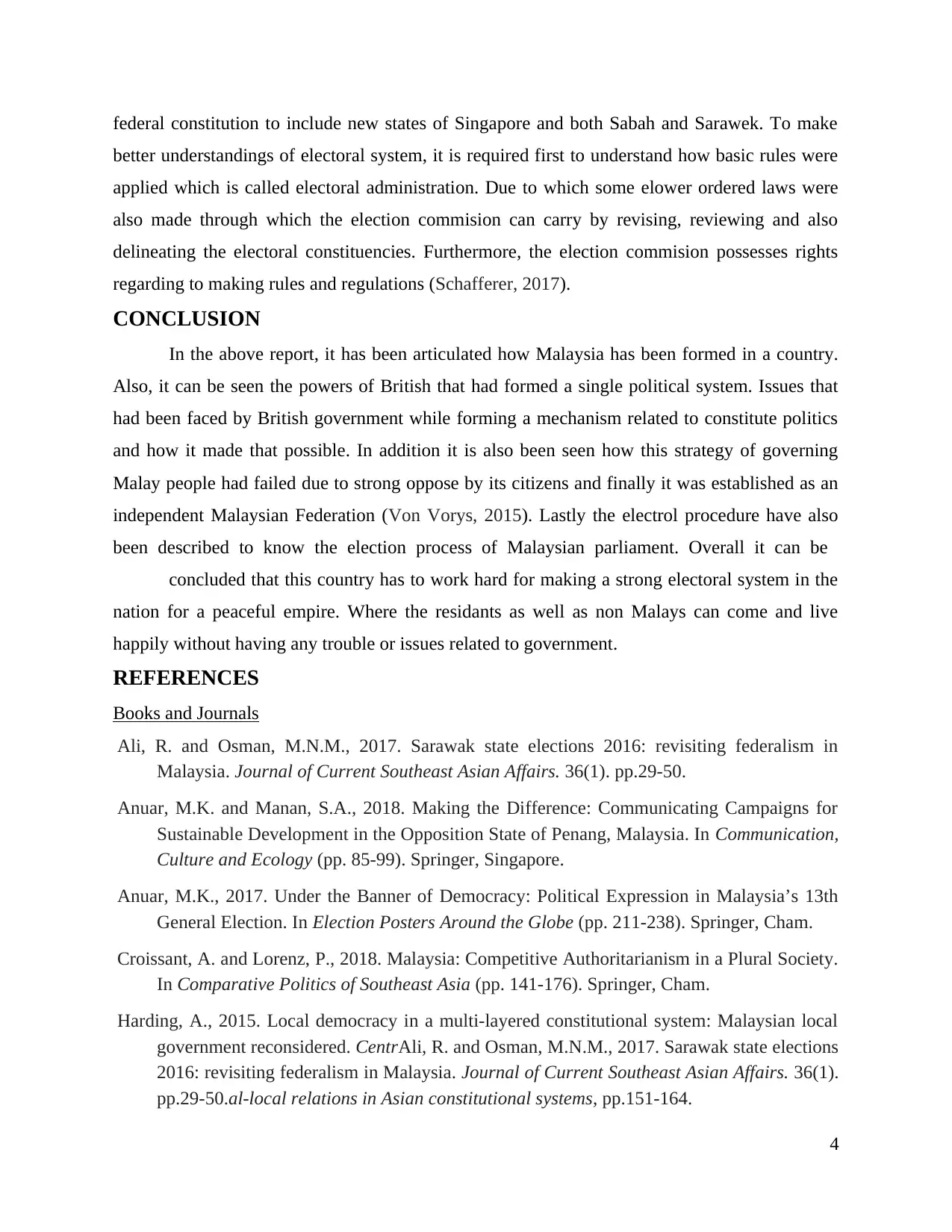
federal constitution to include new states of Singapore and both Sabah and Sarawek. To make
better understandings of electoral system, it is required first to understand how basic rules were
applied which is called electoral administration. Due to which some elower ordered laws were
also made through which the election commision can carry by revising, reviewing and also
delineating the electoral constituencies. Furthermore, the election commision possesses rights
regarding to making rules and regulations (Schafferer, 2017).
CONCLUSION
In the above report, it has been articulated how Malaysia has been formed in a country.
Also, it can be seen the powers of British that had formed a single political system. Issues that
had been faced by British government while forming a mechanism related to constitute politics
and how it made that possible. In addition it is also been seen how this strategy of governing
Malay people had failed due to strong oppose by its citizens and finally it was established as an
independent Malaysian Federation (Von Vorys, 2015). Lastly the electrol procedure have also
been described to know the election process of Malaysian parliament. Overall it can be
concluded that this country has to work hard for making a strong electoral system in the
nation for a peaceful empire. Where the residants as well as non Malays can come and live
happily without having any trouble or issues related to government.
REFERENCES
Books and Journals
Ali, R. and Osman, M.N.M., 2017. Sarawak state elections 2016: revisiting federalism in
Malaysia. Journal of Current Southeast Asian Affairs. 36(1). pp.29-50.
Anuar, M.K. and Manan, S.A., 2018. Making the Difference: Communicating Campaigns for
Sustainable Development in the Opposition State of Penang, Malaysia. In Communication,
Culture and Ecology (pp. 85-99). Springer, Singapore.
Anuar, M.K., 2017. Under the Banner of Democracy: Political Expression in Malaysia’s 13th
General Election. In Election Posters Around the Globe (pp. 211-238). Springer, Cham.
Croissant, A. and Lorenz, P., 2018. Malaysia: Competitive Authoritarianism in a Plural Society.
In Comparative Politics of Southeast Asia (pp. 141-176). Springer, Cham.
Harding, A., 2015. Local democracy in a multi-layered constitutional system: Malaysian local
government reconsidered. CentrAli, R. and Osman, M.N.M., 2017. Sarawak state elections
2016: revisiting federalism in Malaysia. Journal of Current Southeast Asian Affairs. 36(1).
pp.29-50.al-local relations in Asian constitutional systems, pp.151-164.
4
better understandings of electoral system, it is required first to understand how basic rules were
applied which is called electoral administration. Due to which some elower ordered laws were
also made through which the election commision can carry by revising, reviewing and also
delineating the electoral constituencies. Furthermore, the election commision possesses rights
regarding to making rules and regulations (Schafferer, 2017).
CONCLUSION
In the above report, it has been articulated how Malaysia has been formed in a country.
Also, it can be seen the powers of British that had formed a single political system. Issues that
had been faced by British government while forming a mechanism related to constitute politics
and how it made that possible. In addition it is also been seen how this strategy of governing
Malay people had failed due to strong oppose by its citizens and finally it was established as an
independent Malaysian Federation (Von Vorys, 2015). Lastly the electrol procedure have also
been described to know the election process of Malaysian parliament. Overall it can be
concluded that this country has to work hard for making a strong electoral system in the
nation for a peaceful empire. Where the residants as well as non Malays can come and live
happily without having any trouble or issues related to government.
REFERENCES
Books and Journals
Ali, R. and Osman, M.N.M., 2017. Sarawak state elections 2016: revisiting federalism in
Malaysia. Journal of Current Southeast Asian Affairs. 36(1). pp.29-50.
Anuar, M.K. and Manan, S.A., 2018. Making the Difference: Communicating Campaigns for
Sustainable Development in the Opposition State of Penang, Malaysia. In Communication,
Culture and Ecology (pp. 85-99). Springer, Singapore.
Anuar, M.K., 2017. Under the Banner of Democracy: Political Expression in Malaysia’s 13th
General Election. In Election Posters Around the Globe (pp. 211-238). Springer, Cham.
Croissant, A. and Lorenz, P., 2018. Malaysia: Competitive Authoritarianism in a Plural Society.
In Comparative Politics of Southeast Asia (pp. 141-176). Springer, Cham.
Harding, A., 2015. Local democracy in a multi-layered constitutional system: Malaysian local
government reconsidered. CentrAli, R. and Osman, M.N.M., 2017. Sarawak state elections
2016: revisiting federalism in Malaysia. Journal of Current Southeast Asian Affairs. 36(1).
pp.29-50.al-local relations in Asian constitutional systems, pp.151-164.
4
⊘ This is a preview!⊘
Do you want full access?
Subscribe today to unlock all pages.

Trusted by 1+ million students worldwide
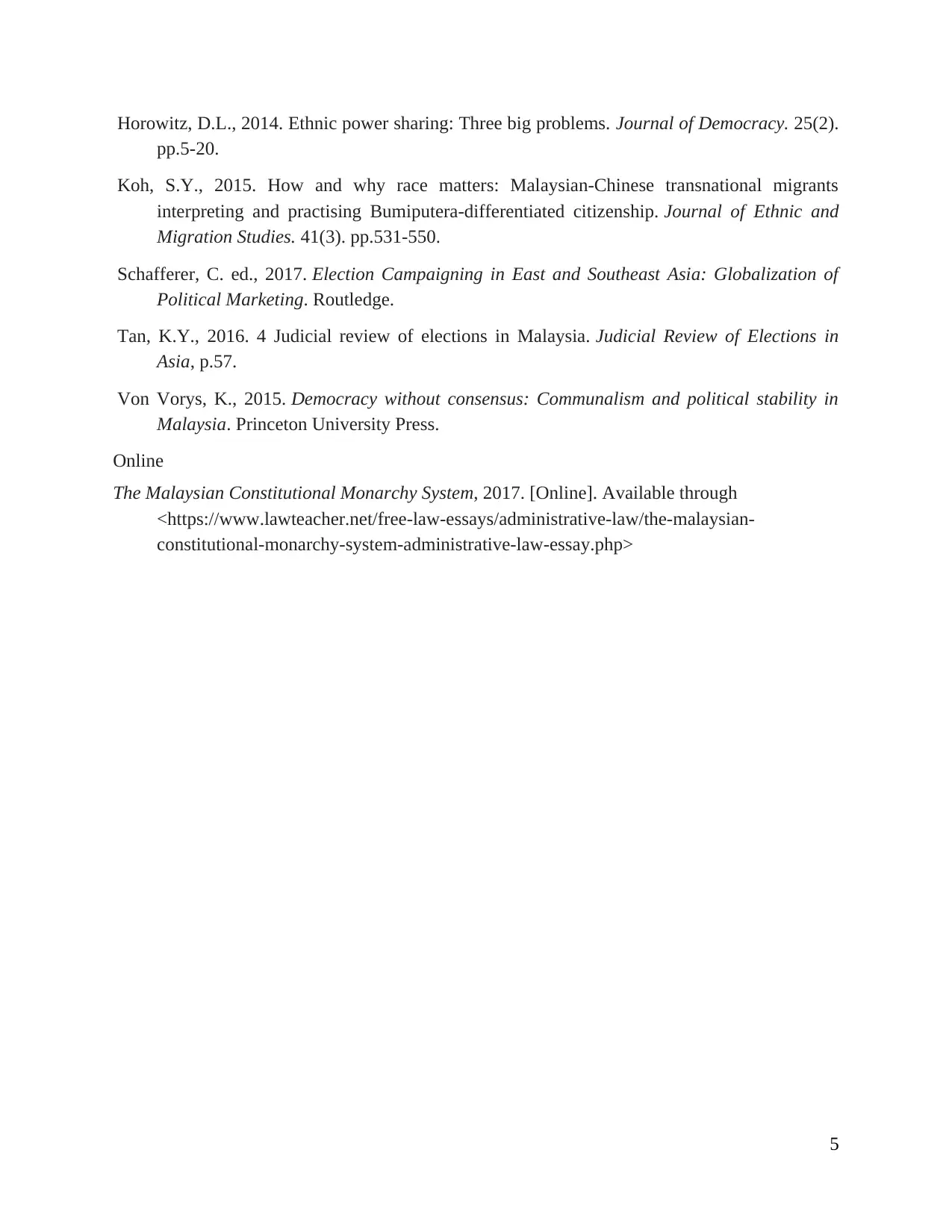
Horowitz, D.L., 2014. Ethnic power sharing: Three big problems. Journal of Democracy. 25(2).
pp.5-20.
Koh, S.Y., 2015. How and why race matters: Malaysian-Chinese transnational migrants
interpreting and practising Bumiputera-differentiated citizenship. Journal of Ethnic and
Migration Studies. 41(3). pp.531-550.
Schafferer, C. ed., 2017. Election Campaigning in East and Southeast Asia: Globalization of
Political Marketing. Routledge.
Tan, K.Y., 2016. 4 Judicial review of elections in Malaysia. Judicial Review of Elections in
Asia, p.57.
Von Vorys, K., 2015. Democracy without consensus: Communalism and political stability in
Malaysia. Princeton University Press.
Online
The Malaysian Constitutional Monarchy System, 2017. [Online]. Available through
<https://www.lawteacher.net/free-law-essays/administrative-law/the-malaysian-
constitutional-monarchy-system-administrative-law-essay.php>
5
pp.5-20.
Koh, S.Y., 2015. How and why race matters: Malaysian-Chinese transnational migrants
interpreting and practising Bumiputera-differentiated citizenship. Journal of Ethnic and
Migration Studies. 41(3). pp.531-550.
Schafferer, C. ed., 2017. Election Campaigning in East and Southeast Asia: Globalization of
Political Marketing. Routledge.
Tan, K.Y., 2016. 4 Judicial review of elections in Malaysia. Judicial Review of Elections in
Asia, p.57.
Von Vorys, K., 2015. Democracy without consensus: Communalism and political stability in
Malaysia. Princeton University Press.
Online
The Malaysian Constitutional Monarchy System, 2017. [Online]. Available through
<https://www.lawteacher.net/free-law-essays/administrative-law/the-malaysian-
constitutional-monarchy-system-administrative-law-essay.php>
5
1 out of 7
Your All-in-One AI-Powered Toolkit for Academic Success.
+13062052269
info@desklib.com
Available 24*7 on WhatsApp / Email
![[object Object]](/_next/static/media/star-bottom.7253800d.svg)
Unlock your academic potential
Copyright © 2020–2025 A2Z Services. All Rights Reserved. Developed and managed by ZUCOL.

